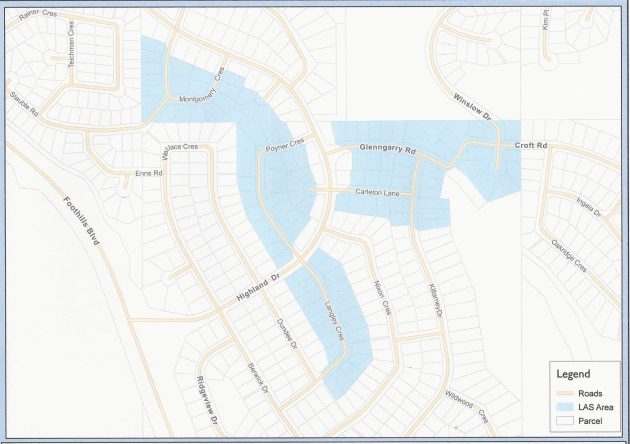City to Seek Permission for Another Local Area Service in the Hart
Areas in blue are properties to be canvassed for possible sewer connection project – image courtesy City of Prince George
Prince George, B.C. – The City of Prince George will be taking the next step to see if there is support to add another 106 Hart Highlands properties to the City’s sewer system.
In a report to Council this evening, staff indicate there is favourable interest in such a project, which early estimates peg at between $2.3 and $2.8 million dollars, but a formal petition process will have to be conducted to ensure there is support from at least 50% of the property owners representing at least 50% of the total assessed values in the area.
As has been the case in recent upgrades in this area of the City, the residents will be responsible for paying their portion of the cost. That means each residential property could expect to pay $22 thousand to $27 thousand dollars over 20 years in a special tax levy.
If the petition produces the necessary approval, the work on the project could start in 2018.


Comments
I would suggest that they put it out to tender as what i have seen done on ridge vie Nixon and Berwick was a joke the way city did it and time it toke to do not to mention how much it coast.
There are two things with this article that need to be clarified in my mind.
1. “City to seek permission for another local area service in the Hart”. This implies that its the City that wants these sewer systems put in. The entire issue has been brought up and spearheaded by RESIDENTS of the area. The city is merely facilitating the process under the Municipal Act. If residents follow protocol under the act,(which they have done here)the City is obligated by the act to follow up. If there’s enough interest from the residents,(50%+) it goes ahead.
2. “…residents will be responsible for paying a portion of the cost.”
Residents are responsible for paying the entire cost. The only portion the city MAY kick in, is the apportion of the paving as the condition of existing dictates. Meaning if it was due to be re-paved in the next year or so anyway, the resident covers less of the cost. Otherwise the entire cost goes to the residents.
As far as contracting out the work. This has been covered over and over again. It costs the tax payer money to go through the process only to prove the fact again that doing it in-house is cheaper for the resident.
Seeing as the Mayor and council love giving free interest loan to a downtown hotel..how about the taxpayers getting the same choice? They also have no interest in checking into contracting out the work..someone needs to pay the city employeees’ wages..as for the pavement, the owners will pay 12% of the cost and of course water lines have to be updated another 12% to the bundle and list goes on and on.
The money borrowed to do this work is actually borrowed at a very low interest rate. The owners involved with this LAS process have the choice of paying up front to avoid the interest, or though their taxes. You also contradict yourself in your reasoning for the city not wanting to contact this work out. These workers are on the payroll anyway, why not have them involved in a LAS where their cost is covered by the project. This frees up tax payers’ money normally paying their wages during this period for something else. As a tax payer, I would rather have this option than pay a general contractor operating cost plus profit.
Take some time to look into the fiscals of these LAS projects. You’ll find your concerns are explained fairly clearly. As for the 12%. This is assessed on a project by project basis and is fair to tax payers not involved with the LAS project. Waterlines were not touched on my phase of the project but I cant speak to the others that followed. Lets here the rest of your list that goes on and on.
**Hear
Attend the next meeting so you get the facts regarding pavement and water lines.As for the employees’ wages..cost saving to the city and keeps them on the payroll…why should homeowners pay for sewer when the city received $6 million to do it in the first place. Where did the money go?
Comments for this article are closed.